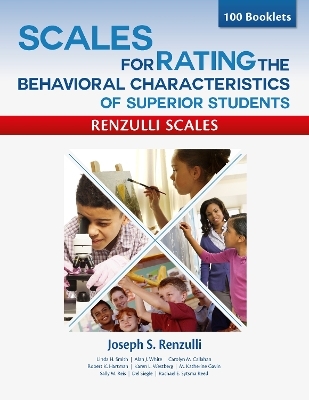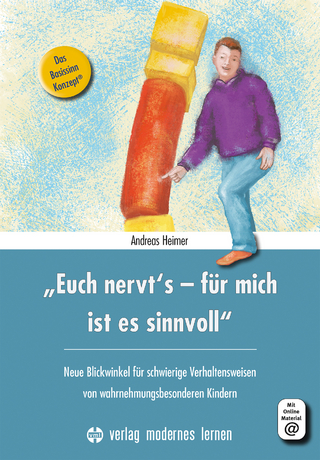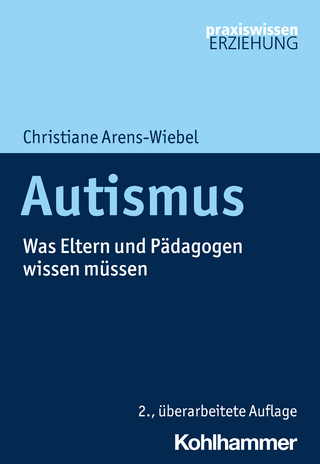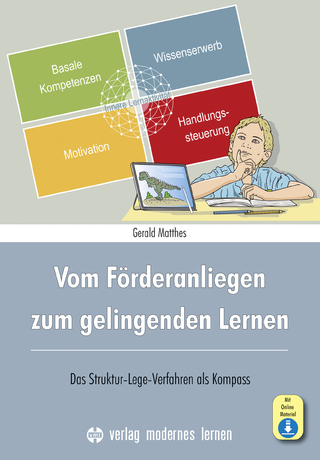
Scales for Rating the Behavioral Characteristics of Superior Students--Print Version
100 Booklets
Seiten
2021
|
3rd edition
Prufrock Press (Verlag)
978-1-61821-098-2 (ISBN)
Prufrock Press (Verlag)
978-1-61821-098-2 (ISBN)
Based on a multiple talent approach to the identification of gifted students, fourteen scales help identify student strengths in the following areas: learning, motivation, creativity, leadership, art, music, dramatics, planning, communication (precision and expression), mathematics, reading, science, and technology. 100 Booklets
The Scales for Rating the Behavioral Characteristics of Superior Students are commonly referred to as the
Renzulli Scales
or
Renzulli-Hartman Scales
.
Now in its third edition, the Renzulli Scales are the nation's most popular tool for identifying gifted children. Supported by 40 years of research, the Renzulli Scales are used by gifted and talented programs across the country. This standardized instrument is completed by teachers and provides an effective method for identifying gifted children. The Renzulli Scales are designed to obtain teacher estimates of a student's characteristics in the following areas:
Learning Characteristics
Creativity Characteristics
Motivation Characteristics
Leadership Characteristics
Artistic Characteristics
Musical Characteristics
Dramatics Characteristics
Communication Characteristics (Precision)
Communication Characteristics (Expressiveness)
Planning Characteristics
Mathematics Characteristics
Reading Characteristics
Technology Characteristics
Science Characteristics
Each scale contains multiple items that are rated using a Likert-type scale. The first four scales (learning, creativity, motivation, and leadership) are used by most schools that use the Scales. The remaining 10 scales are focused on specific areas. They are used by schools when those areas seem appropriate for a gifted program's goals. For example, a program serving gifted math students would use the mathematics scale, a science academy would use the science scale, etc.
Research shows that gifted children tend to exhibit certain observable behaviors, such as using advanced vocabulary, grasping underlying principles, and making generalizations from complex information. The Renzulli Scales asks teachers to rate children in comparison to their peers on a host of these observable behaviors. The children who score high on the scales are more likely to be gifted. Using a tool like the Scales, a school can narrow the number of students who will be fully evaluated for a gifted program.
The items were chosen from a comprehensive body of research concerning the characteristics of gifted students. Based on a multiple talent approach to the identification of gifted students, the scales help identify student strengths.
To explore the full collection of Renzulli Scales print and online resources, please visit: https://www.routledge.com/go/scales-for-rating-the-behavioral-characteristics-of-superior-students.
The Scales for Rating the Behavioral Characteristics of Superior Students are commonly referred to as the
Renzulli Scales
or
Renzulli-Hartman Scales
.
Now in its third edition, the Renzulli Scales are the nation's most popular tool for identifying gifted children. Supported by 40 years of research, the Renzulli Scales are used by gifted and talented programs across the country. This standardized instrument is completed by teachers and provides an effective method for identifying gifted children. The Renzulli Scales are designed to obtain teacher estimates of a student's characteristics in the following areas:
Learning Characteristics
Creativity Characteristics
Motivation Characteristics
Leadership Characteristics
Artistic Characteristics
Musical Characteristics
Dramatics Characteristics
Communication Characteristics (Precision)
Communication Characteristics (Expressiveness)
Planning Characteristics
Mathematics Characteristics
Reading Characteristics
Technology Characteristics
Science Characteristics
Each scale contains multiple items that are rated using a Likert-type scale. The first four scales (learning, creativity, motivation, and leadership) are used by most schools that use the Scales. The remaining 10 scales are focused on specific areas. They are used by schools when those areas seem appropriate for a gifted program's goals. For example, a program serving gifted math students would use the mathematics scale, a science academy would use the science scale, etc.
Research shows that gifted children tend to exhibit certain observable behaviors, such as using advanced vocabulary, grasping underlying principles, and making generalizations from complex information. The Renzulli Scales asks teachers to rate children in comparison to their peers on a host of these observable behaviors. The children who score high on the scales are more likely to be gifted. Using a tool like the Scales, a school can narrow the number of students who will be fully evaluated for a gifted program.
The items were chosen from a comprehensive body of research concerning the characteristics of gifted students. Based on a multiple talent approach to the identification of gifted students, the scales help identify student strengths.
To explore the full collection of Renzulli Scales print and online resources, please visit: https://www.routledge.com/go/scales-for-rating-the-behavioral-characteristics-of-superior-students.
Joseph Renzulli is a professor of educational psychology at the University of Connecticut, where he also has served as the director of the Renzulli Center For Creativity, Gifted Education, and Talent Development.
Scales for Rating the Behavioral Characteristics of Superior Students, Learning Characteristics, Creativity Characteristics, Motivation Characteristics, Leadership Characteristics, Artistic Characteristics, Musical Characteristics, Dramatics Characteristics, Communication Characteristics (Precision), Communication Characteristics (Expressiveness, Planning Characteristics, Mathematics Characteristics, Reading Characteristics, Technology Characteristics, Science Characteristics
| Erscheinungsdatum | 13.07.2021 |
|---|---|
| Sprache | englisch |
| Maße | 216 x 279 mm |
| Gewicht | 9480 g |
| Themenwelt | Schulbuch / Wörterbuch |
| Sozialwissenschaften ► Pädagogik ► Sonder-, Heil- und Förderpädagogik | |
| ISBN-10 | 1-61821-098-X / 161821098X |
| ISBN-13 | 978-1-61821-098-2 / 9781618210982 |
| Zustand | Neuware |
| Haben Sie eine Frage zum Produkt? |
Mehr entdecken
aus dem Bereich
aus dem Bereich
das Struktur-Lege-Verfahren als Kompass
Buch | Softcover (2024)
modernes lernen (Verlag)
23,95 €


